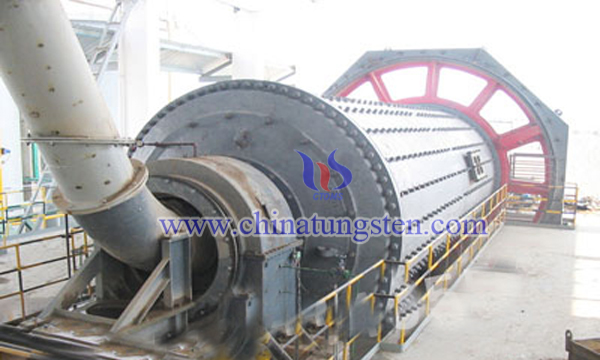Roasting Tungsten Mineral Raw Material Flue Gas Spray Wastewater Treatment Process
- Details
- Category: Tungsten Information
- Published on Thursday, 07 June 2018 17:04
During the treatment of ammonium para tungstate, the high temperature oxidation roasting of tungsten mineral materials was carried out in the rotary kiln, and the tungsten mineral raw materials were derived from the low temperature end of the kiln tail and out of the kiln head after the high temperature section. The fuel and air enter and burn after the kiln head, and the flue gas is discharged from the low temperature end of the kiln. The flotation reagents and other organic substances contained in tungsten mineral raw materials are partly removed at high temperature and partly evaporate in the low temperature section of the kiln bottom and enter the roasting flue gas. Tungsten minerals usually contain arsenic containing minerals. Under roasting conditions, some forms of arsenic, such as As2S3 and As2S5, will be roasted in the form of gaseous state and will also enter the roasted flue gas. Dust and sulfur and phosphorus can also enter into the roasting flue gas.

The flue gas emission reduction treatment of the calcined tungsten mine is used to remove the harmful impurities such as acid gas and arsenic in the flue gas, and the discharge of the waste water from the flue gas of the tungsten mineral raw materials is small, but its composition is very complex. The existing technology is combined with other production wastewater to deal with together, which increases the difficulty of mixing wastewater treatment, and improves the comprehensive treatment cost of wastewater.
In order to improve the cost of wastewater treatment, some researchers have improved the traditional flue gas treatment methods, using solid liquid separation, acid oxidation, heavy metal removal, pH value regulation and two stage solid-liquid separation process.
In the first stage solid-liquid separation process, centrifugation, filtration or filter filtration are used for solid-liquid separation, and the main components are tungsten minerals used in the production of ammonium para tungstate, and the filtrate is transferred to the acid regulating oxidation process.
In the process of acid adjustment oxidation, the temperature of acid regulating oxidation is 0~100°C and time is 24~96 hours; acid adjustment is 1 ≤pH ≤5, and oxidizing agent is nitrate and / or nitric acid and / or hydrogen peroxide. The oxidant used is nitrate or nitric acid or hydrogen peroxide.
Heavy metals removal: the agent of heavy metal removal is iron salt.
In the pH adjustment process, the acidity and alkalinity of the solution with pH regulator is 8 ≤pH ≤14, and the heat preservation reaction is more than 1 hours, and the pH regulator is sodium carbonate or sodium hydroxide or calcium hydroxide or calcium carbonate.
Two stage solid-liquid separation process: two stage solid-liquid separation using centrifugal, filter or pressure filtration.
Through the process improvement, the enterprise can effectively remove most of the main pollution factors in the roasted flue gas spray wastewater. The removal rate of COD and the removal rate of arsenic can reach 95% and 99% respectively. The effluent can be discharged directly after treatment, which can reduce the difficulty of the treatment of mixed wastewater and reduce the cost of the comprehensive treatment of wastewater.
- Tungsten Manufacturer & Supplier, Chinatungsten Online: www.chinatungsten.com
- Tungsten News & Prices of China Tungsten Industry Association: www.ctia.com.cn
- Molybdenum News & Price: news.molybdenum.com.cn
- Tel.: 86 592 5129696; Fax: 86 592 5129797; Email: sales@chinatungsten.com



 sales@chinatungsten.com
sales@chinatungsten.com